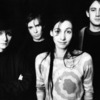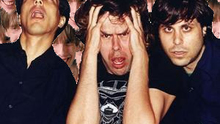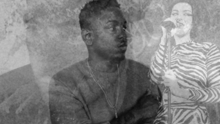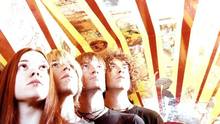On listening to How To Dress Well’s debut LP Love Remains, it was clear to me that Tom Krell thinks in terms of musical 'suites'. Aside from the more obviously overarching links (like the ‘Suicide Dream’ trilogy), the bleeding between songs and ideas runs far deeper than the song titles. Echoes of melody resurface through the fuzzed out textures of melancholic bedroom R&B, implying a structure to the album greater than the sum of its individual songs. And indeed, with this year’s excellent Total Loss, Krell has taken this holistic approach to creation a step further, creating a record with an ear for pacing as graceful as his voice; using lyrics and musical motifs which recur and evolve across eleven tracks to paint a wholly conceived entity, absorbing from beginning to end.
“The first record is a collection which is quite dutifully and carefully assembled”, Krell explains. “But this record is a whole project. It's really important to me that it gets viewed like that too… You have no idea the kind of stress I suffered I had sequencing Total Loss” However, it’s painstakingly evident how much effort went into the construction of Total Loss, or at least that something with such a dramatic sense of structure and naturalistic ebb and flow didn’t just happen by letting the chips fall where they may.
“There were so many different sequences across the record”, he explains, recalling his painstaking efforts deciding how Total Loss should play out; attempting to map a conflation of the music, the lyrics, and his ever-evolving emotional responses to the songs into something achieving maximum impact upon its listener. “At one point I thought 'Say My Name' should be the first song, but then I realised that the only way that the desire described in that song for true solitude gets its meaning is by building a trust in the world... At one point I was pushed by the label to have the interlude as the first track, but it was really important to me that the record began first with life, then my voice. That's why it starts with this field recording of a train, then this piano builds up, then this voice pierces through the wintery textures of noise. I learned what the record was by making it, and when I finally felt like I'd seen it right, I finally had the sequence that you have.”
Clearly, Krell is an artist who spends a lot more time than most thinking about how the tiniest components of an individual song’s texture provide an effect which contribute to its album’s whole, and to the trajectory of the journey which the listener experiences. While most artists’ consideration of track listing might extend only to striking the correct flow between loud and quiet, fast and slow, Krell goes layers deeper, considering his own personal relationship to a particular instrument or turn of phrase and how one expression of emotion through sound gives rise to the next in a logical and naturalistic way. “To me, songs are always in plural, and they always belong together in little mesh-works of communications between their melodies and textures and lyrics”, he concurs. “I don’t think of myself as a songwriter as writing individual songs. When I'm writing a song, I always end up opening up two or three other songs. Songwriting for me is always in plural form – a series of songs together. The terms of what makes a whole thing a whole is going to be different from record to record, but they'll always be these journeys.”
And indeed, it’s clear that it’s these overarching journeys which excite Krell most as a conveyor of music, frequently speaking with fevered animation about how he’s building new ideas into current works in progress and imagining how they might begin to fit together into an interconnected entity. We were speaking about a new song he’d been playing live of late, when he began to tell me about the newest stage in its evolution: “I've inserted this new verse at the end where after the intense development of noise, it cuts out completely and it’s just me singing over this guitar sample. And the sample I based that on was this acoustic and oboe loop. And I think when I take this song to the studio, I'll leave that dynamism in it... I think that song happening in the middle of a record which starts with really, really pared down, fuzzy acoustic guitar, then builds into some songs on piano, then builds into this oboe and guitar loop, and then builds into this wall of noise and comes back down... I'm not sure where it goes from there”, he admits, falling out of the accelerating stream-of-consciousness thought experiment he’d lost himself in – “but that's already starting to look like an album”.
---
---
From the starting point of describing a song which actually exists, Krell can’t help himself but to lapse into imagining its place within an eventual whole, as part of a series of peaks and troughs, builds and releases. Speaking like this as frequently as he does, Krell betrays an ability to visualise an extended aural trajectory which more than explains the drama with which the instrumental of ‘World I Need You, Won’t Be Without You’, recurs within ‘Talking To You’ with wrought intensity, echoing off its earlier incarnation, and how the cathartic release of ‘Set It Right’ in turn explodes out of the vulnerability carefully woven before it. In explaining the use of imagery in his live shows, Krell explains that “the songs are connected with images… and the whole thing becomes an aesthetic experience”. He speaks of the “colour” of songs as they get reflected in different emotional contexts, how he is able to “see” the correct sequence of tracks, and how an idea he explains verbally has started to “look like an album”.
However, I was mistaken to believe that – unlike Love Remains which comes across as a collection of songs put together nicely but clearly conceived of separately – Total Loss might have been written from A to B, or that Krell starts from the beginning of what becomes his eventual path, and writes himself through the record in sequence. I was surprised to learn, for instance, that the three usages of the line “you were there for me when I was in trouble” were written completely out of order in relation to how they appear through his recorded output, despite their sounding so purposefully amplified in intensity and meaning with each reappearance.
“The first song was deeply sad. I wrote that song at Christmas in my parents' basement just after my best friend had died, and that was such a painful kind of longing when I first wrote it. And then the second time I wrote that lyric was in Struggle, which was about four weeks after that, and it's an angry song to me And then the third time I wrote that phrase was for 'When I Was In Trouble' which was actually for my Mom, who hasn’t passed but in a series of fundamental ways has passed… She's old now and suffers from quite a bit of mental instability and challenges which create quite a perplexing role reversal for us. And that line recurred there and brought these different things from my life and my thinking together.”
Yet, in spite of this apparent contradiction, this difficulty in turning muddled real-life chronology into something coherent on record, one of Krell’s strongest penchants is his ability to not just hear his way through a record from the inside, but to look at it from above and put what he’s created into what feels like their correct sequencing; musically, thematically and emotionally. Speaking about how the record’s final song was written first, and its first song written last (itself the ultimate refutation of the idea that Krell’s records are both envisioned and executed in a linear fashion) Krell attempts to explain how his records congeal into unity in spite of this ostensible paradox.
“[‘When I Was In Trouble’ and ‘Ocean Floor For Everything’] came in a reverse temporal order, but for me, for the experience of the album as a whole, and the lessons I learned from the album as a whole, 'When I Was In Trouble' comes first. It's often the case in psychic life too, you'll find later something which was affecting things from the get-go. That's the weird anachronism of time – you learn only later what in fact you meant to mean at a much earlier stage, and that re-inflects the whole path with a different light. I knew that Ocean Floor was an important song to me, but I didn’t realise how important until the very end when I wrote Trouble and I realised that there was a whole constellation of tension, problems and struggles which pushed me in a moment of real hope to write Ocean Floor. Then I had to come back from that moment and find my way there, and finding that first step with Trouble brought it all together as a whole.”
---
---
Arriving at the eventual unity of Total Loss was entirely about fluid, dynamic evolution within the composition his songs and their interrelations, and nothing to do with prescriptively connecting the dots within a conceptual framework set into stone from the outset. The act of creation in and of itself guided, informed and ultimately shaped the robust trajectory which we hear. Krell admits to “constantly making little changes to the lyrics, constantly making little affective differences which will change the whole meaning of a song to me” and he is at pains to distance himself from someone who works to a pre-established vision at the expense of free spirited and exploratory creation. “I didn't have the concept and then write”, he asserts, while speculating about the potential of his recent obsession of the contrast between the hyper-loud and the hyper-quiet. “I've learned so much about my own emotional life and my own relationship with my family, past and future through writing these songs, and once that stops I think I’d stop making music. I'd hate to make a record from a concept. I'm not this heavy conceptualist guy.”
Nevertheless, above anything else, Krell can’t resist losing himself into verbalised daydreams of what he might explore at album-length next, not even slightly shying away from his wildest instincts like an idea of “recording a whole record crib-side, a record of tiny sounds which score an infant's sleep without waking them” – displaying a willingness to, as he puts it, “follow little intuitions out”. But speaking about what might be most likely to come next in light of the context provided by his previous records, Krell speculates that “the next thing I see the project needing is more ostensible nakedness. Love Remains was, on the surface, pure electric noise - with a total naked humanity. The movement from that to Just Once was a really reactive, really alternate, and then Total Loss moved back, splitting the difference. With the next one, rather than pure noise, pure electric composition with humanity buried in it, it'll be the reverse of that where this raw, open naïve humanity sits on a bed of totally controlled, disciplined electronic stuff.”
“Total Loss was like checking off all the affective stations of mourning – anger, frustration, suffocating depression, sudden bursts of elation, clear vision of self, moments of simple happiness, real aversive and visceral joy in the face of death – it was sketching a whole affect. With the new record I want to chart the development of a sound, from a really simple, rudimentarily recorded simple organic sound, to the most full-blooded, hyper-visceral produced sounds, and back again, and who knows how many times I have to do that to trace the sonic development. I think the next record is going to me more about sonic adventure rather than an adventure of feelings.”
But no matter how confidently Krell sketches out these concepts, he always checks himself by adding the disclaimer that this is “just speculation”. He admits that “I thought for sure that when I put out Love Remains that I was stoked to put out the noisiest record anyone had ever heard, then some things happened in my life, and the new record actually came out quite clean, with a lot of space”. Three records into his career, Krell’s output as How To Dress Well has carved out three very different niches with each incarnation, all the while sounding unmistakably the work of the same creator. The two common factors are clear: firstly, there’s the voice; secondly, there’s a dedication to record-long attention to detail in pacing. Whether Krell moves further away from noise and closer to organic instrumentation or exactly the opposite, one thing can be said for sure: the next record will be born of a responsive and honest relationship with Krell’s own emotions, and of his devotion to the affective power of sound as a cumulative force. “The terms of what makes a whole thing a whole is going to be different from record to record”, he concedes “but they'll always be these journeys.”
---























